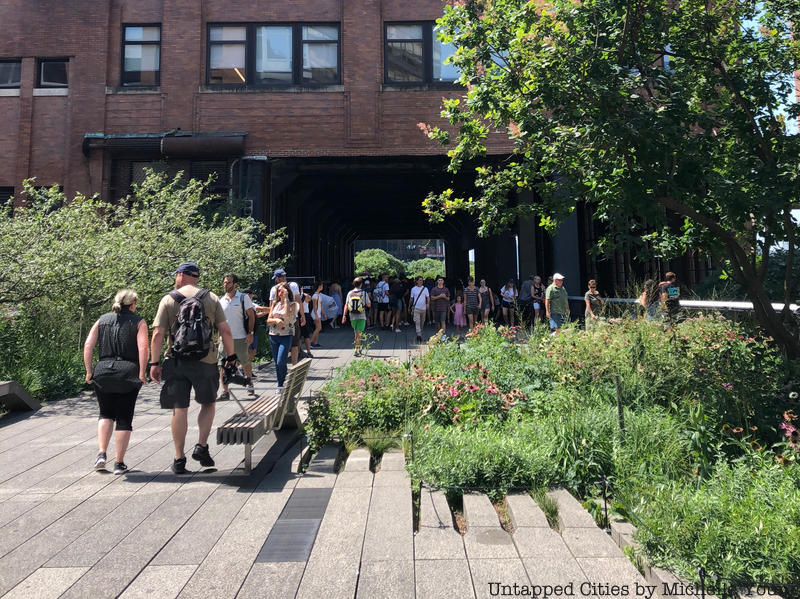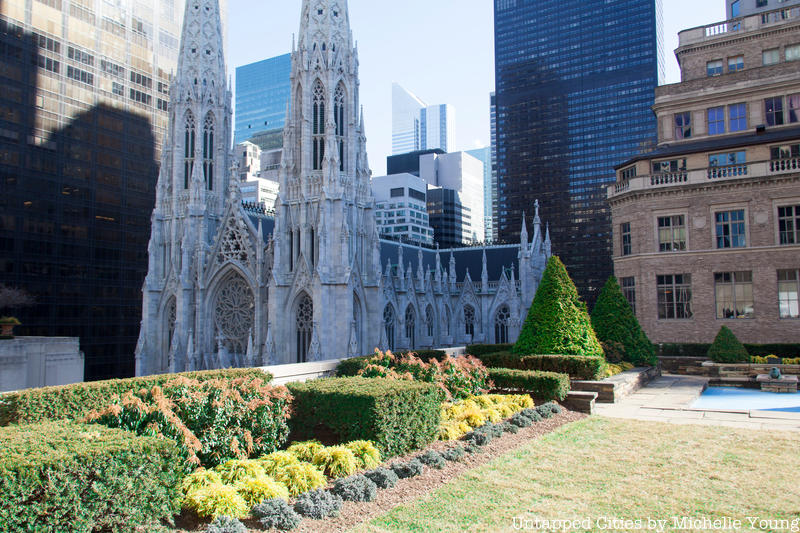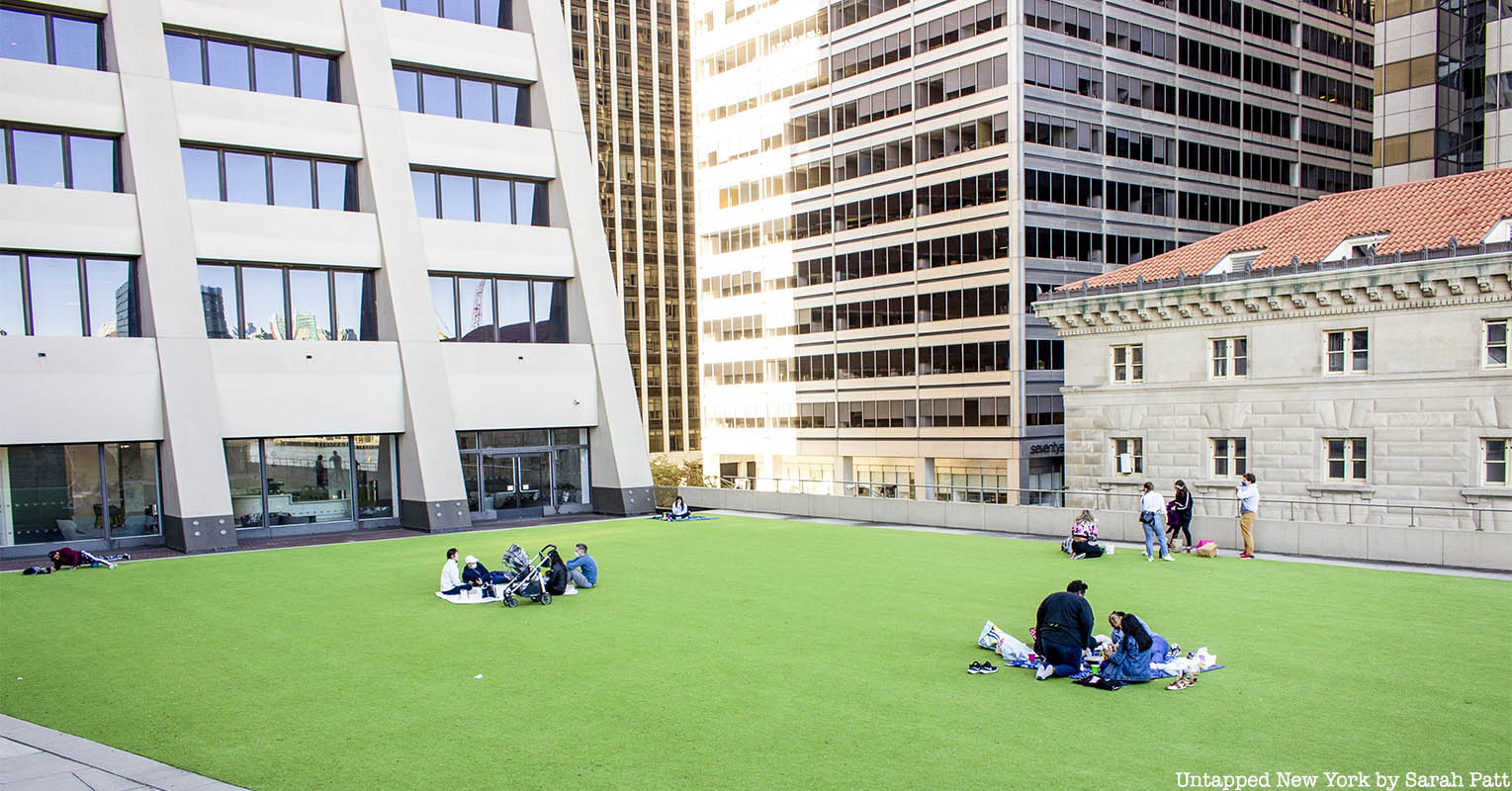
While Central Park or Prospect Park may be the spaces most commonly associated with parks in New York City, the diversity of the built environment here allows for a plethora of non-traditional open spaces. In the past, we’ve covered everything from Manhattan’s tiniest parks, to privately owned public spaces and indoor public spaces, to pocket parks. We also recently showcased the five New York City parks larger than Central Park. Now, we turn our attention to a type of open space made possible in a multi-level, multi-layered city: the elevated park and garden, sometimes hidden from view at street level. Here are ten to check out:
1. The Rooftop Gardens of Rockefeller Center

Atop Rockefeller Center, there are at least four immaculately manicured gardens. Above 610 and 620 Fifth Avenue (pictured above) are two matching gardens, with one used as an event space called 620 Loft &Garden. Both have a landscape design featuring shaped hedges around a central green, along with a rectangular blue pool where water spouts from a fountain in the shape of a frog. You may have caught the location featured in television shows like Gotham and Daredevil as well.

View from 620 Loft & Garden
At 630 Fifth Avenue, the building next door across 50th Street, there are two more gardens. One is the terrace of the Tishman Speyer office, which has more lush landscaping than 620 Loft & Garden with trees, flowers, and urns around an elevated grassy area. Check out our photos visiting all of these hidden gardens previously here.
2. The High Line

Easily Manhattan’s most recognizable elevated green space, the High Line was originally a freight viaduct for the New York Central Railroad. The elevated train line was known then as the West Side Elevated Line and was constructed in response to the high number of pedestrian deaths along 10th Avenue (nicknamed “Death Avenue”) which was shared by freight trains, trucks, carts, automobiles and pedestrians. Starting in the 19th century, a team of “West Side Cowboys” would assist traffic by waving flags on horseback to alert pedestrians of oncoming freight trains. The West Side Elevated Line opened in 1933 and operated in until the early 1980s, rendered obsolete by trucking.
Almost immediately following the closing of the rail line, calls for its reuse emerged. Chelsea resident and activist Peter Obletz launched a campaign to “Save the Tracks,” and formed The West Side Rail Line Development Foundation. Still, in the 1990s, five blocks of the High Line were demolished and Mayor Rudolph Guiliani signed a demolition order for the rest of the structure. In 1999, Joshua David and Robert Hammond created the non-profit conservancy, Friends of the High Line, and launched a visioning competition which would eventually lead to support from Mayor Michael Bloomberg and the New York City Council.
The elevated park was designed by landscape design firm James Corner Field Operations, architects Diller Scofidio + Renfro, and planting designer Piet Oudolf. The success of The High Line as a public space, and as a real estate and neighborhood regenerator, have inspired many cities around the world to repurpose their elevated rail structures.
The High Line is also home to many temporary and longer-term art installations and serves as a host for performances. Next up in October is an ambitious work, Mile-Long Opera which will feature 1,000 singers in a single performance along the High Line.
3. Elevated Acre

In one of the busiest neighborhoods in New York City, hidden green spaces can be hard to find. But the Elevated Acre, tucked three stories above street level at 55 Water Street is open 24 hours, 7 days a week. It offers a beautiful unobstructed view of the Brooklyn skyline. Set back from the sidewalk, people often overlook its escalator entrance, meaning you’ll find more locals catching up with friends during their lunch break than you will tourists.
The Elevated Acre was built in the early 1970s, the product of the new 1961 zoning regulation that allowed for bonus height in exchange for a public plaza. While there has been a public space here since the building was built, the latest iteration of the Elevated Acre was completed in 2005 by Rogers Marvel Architects, designers of other public spaces including Bronx’s Mill Pond Park, Washington DC’s Constitution Gardens, and Jersey City’s Berry Lane Park. The architects turned the barren deck space into a vibrant public park, which also has programming like movies and performances.
4. The Lotus Garden

Once upon a time this plot was merely a condominium garage roof, but now it’s a thriving community garden. Lotus Garden, on the Upper West Side’s 97th street, between Broadway and West End Avenues, is one of New York’s first green roofs, and has tall shrubbery, fruit trees, a green wall, flowers, two goldfish ponds, and views of the colorful buildings across the street.
In the late 1980s, community organizers joined to form a committee whose goal was to create a tranquil green space out of an unused roof. Thirty years later, the 1/6th of an acre garden is flourishing thanks to its community members, whose $20/year membership fees help maintain the gardens and plots. Nearly 30 member gardeners work to maintain the beautiful and secluded elevated park, and host family friendly events. Though Lotus Garden is accessible 24/7 to members, it is open to the public every Sunday from 1-4 PM.
5. Liberty Park

Located on the World Trade Center site, the elevated Liberty Park opened in 2016 south of the 9/11 Memorial. It is bookended by the construction site of St. Nicholas Greek Orthodox Church, which is under pause due to financial issues, and the refurbished Liberty Street pedestrian bridge, a remnant from the original World Trade Center site. The elevated nature of the park serves as a practical necessity for the Port Authority as inside and under the park is the World Trade Center vehicle security depot.
Amidst the landscaping is the World Trade Center sphere by Fritz Koenig, which was recovered from the rubble of the 9/11 attacks, moved for about fifteen years to The Battery, and moved back in 2017. Another sculpture at Liberty Park is the America’s Response Monument, an equestrian statue that monument contains a fragment of steel from the World Trade Center. It was commissioned anonymously by a group of Wall Street bankers who had lost friends in 9/11. The statue honors those in the American armed forces that served in response to 9/11.
6. Hunters Point South Park

The second phase of Hunter’s Point South Park in Long Island City has a special architectural feature: all paths lead to an elevated promenade and lookout point that rises 22 feet into the air and is cantilevered 50 feet over the land it’s built. A wooden boardwalk opens up to a wide, panoramic view of the Manhattan skyline and East River. Lee Lim of the architecture firm Weiss/Manfredi tells us that the structure was intended as a “big gesture,” describing it as an “urban building plus ship-like land form.” It’s intended, he says, to give you the “illusion of floating over the water.” According to the park’s fact sheet, it aims to “brings the city to a precipice suspended over the new wetland water’s edge.”
This second phase of the park, which opened earlier this year, is much more contemplative in nature and reflects an increased awareness of resilience and sustainability that has come to the forefront of waterfront design since Hurricane Sandy. The 5.5 acre addition flows seamlessly from the first phase, beginning at 54th Avenue and wrapping around the opening of Newtown Creek, creating a total of 11 acres of waterfront park surrounded by water on three sides.
7. Tudor City Greens

The best word to describe Tudor City Greens? Charming. From the carefully manicured grounds to the flower gardens, bird baths, benches, street lamps, and location looking over East 42nd Street and 2nd Avenue, it feels almost like someone planted a small-town garden right in the middle of Turtle Bay. It’s an elevated park, accessible by steps on East 42nd Street.
Tudor City Greens is unique in that the founder of the Tudor City community, a twentieth-century real-estate developer Fred F. French, oriented the residential buildings around Tudor City Greens, rather than enclosing the gardens within a private courtyard, as seen in New York’s turn-of-the-century Astor courtyard buildings. During the 1920s when French implemented his plan, the idea of centering a neighborhood around a park while also making it accessible to the public rather than enclosing it inside a courtyard was new.
Run by a non-profit organization consisting of local Tudor City community members, the park is open to the public daily from 7AM to 10PM, free of charge.
8. Laurie M. Tisch Illumination Lawn at Lincoln Center

Imagine lounging in the grass of a rolling green hill. Now imagine that hill has panoramic views of Manhattan’s Upper West Side, and is located on top of the restaurant, Lincoln. This is the Laurie M. Tisch Illumination Lawn, a sloped, triangular-shaped building in the middle of Lincoln Center. The roof-park hybrid opened as part of Lincoln Center’s $1.2 billion renovation project, the angled green lawn is accessible to the public free of charge, by steps built into the structure.
As a small and elevated green space, it gives an impression of solitude even amongst the traffic nearby. You wouldn’t think that a lawn in the bustling Lincoln Center could feel secluded, but its elevation and birds-eye view down West 65th Street help to make it feel like a private place.
The grass is kept in place by a permeable plastic cellular mat called a geoweb, and the lawn is named after Laurie M. Tisch, a philanthropist and the project’s main donor. It’s a great space to lounge, tan, picnic, or just relax in.
9. The Metropolitan Museum of Art Rooftop

The Iris and B. Gerald Cantor Roof Garden at the Metropolitan Museum of Art has a lot going for it – sweeping, unobstructed views of Central Park, a bar, and an annual summer art installation that have included Big Bambú, Pierre Huyghes deconstructed rooftop, a reconstruction of the house from Psycho, and this year’s otherworldly work, We Come in Peace by Huma Bhabha, a female artist from Pakistan. We Come in Peace will be up until October 28, 2018.
10. The Queensway

The Queensway is a plan for an elevated linear park along the abandoned Rockaway Beach Branch line of the Long Island Railroad in Queens. The current conditions along the future Queensway vary dramatically, from an earthen embankment to dilapidated overpass bridges to a near-abandoned parking lot. But taken together, a conversion of the rail line into a park could add much needed improved pedestrian connections, recreational space, and accessible green space. The current plan for the first half mile stretch near Forest Park aims to add outdoor nature classrooms, educational plantings, farmers market, and recreational space.
The project faces certain political challenges – Mayor Bill De Blasio and the City of New York have not backed the project yet, and local residents are divided. Some residents prefer a reactivation of the rail line for mass transit, but as Andy Stone, former director of the New York City program of the Trust for Public Land tells us, there have been several initiatives to study reactivation of the Rockaway Beach Branch by the MTA and the Port Authority, but none so far have come to fruition. The latest study is underway, while the first design of the Queensway was completed with over $1 million in public and private sources including a $444,000 grant from the State Office of Parks, Recreation and Historic Preservation and Governor Cuomo’s Regional Economic Development Council, $250,000 from New York State Assembly Member Andrew Hevesi, $250,000 from Queens Council Member Karen Koslowitz, as well as other private donations.
Next, check out the Top 10 Secrets of the High Line. This article was co-written by Michelle Young, Gabrielle Showalter, Natasha Lane, and other Untapped Cities staff.





